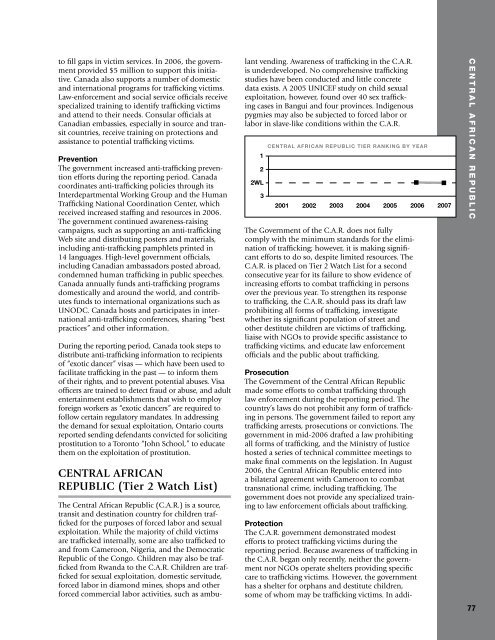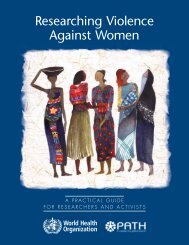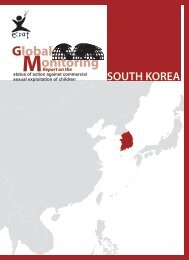2007 Trafficking in Persons Report - Center for Women Policy Studies
2007 Trafficking in Persons Report - Center for Women Policy Studies
2007 Trafficking in Persons Report - Center for Women Policy Studies
You also want an ePaper? Increase the reach of your titles
YUMPU automatically turns print PDFs into web optimized ePapers that Google loves.
to fill gaps <strong>in</strong> victim services. In 2006, the government<br />
provided $5 million to support this <strong>in</strong>itiative.<br />
Canada also supports a number of domestic<br />
and <strong>in</strong>ternational programs <strong>for</strong> traffick<strong>in</strong>g victims.<br />
Law-en<strong>for</strong>cement and social service officials receive<br />
specialized tra<strong>in</strong><strong>in</strong>g to identify traffick<strong>in</strong>g victims<br />
and attend to their needs. Consular officials at<br />
Canadian embassies, especially <strong>in</strong> source and transit<br />
countries, receive tra<strong>in</strong><strong>in</strong>g on protections and<br />
assistance to potential traffick<strong>in</strong>g victims.<br />
Prevention<br />
The government <strong>in</strong>creased anti-traffick<strong>in</strong>g prevention<br />
ef<strong>for</strong>ts dur<strong>in</strong>g the report<strong>in</strong>g period. Canada<br />
coord<strong>in</strong>ates anti-traffick<strong>in</strong>g policies through its<br />
Interdepartmental Work<strong>in</strong>g Group and the Human<br />
<strong>Traffick<strong>in</strong>g</strong> National Coord<strong>in</strong>ation <strong>Center</strong>, which<br />
received <strong>in</strong>creased staff<strong>in</strong>g and resources <strong>in</strong> 2006.<br />
The government cont<strong>in</strong>ued awareness-rais<strong>in</strong>g<br />
campaigns, such as support<strong>in</strong>g an anti-traffick<strong>in</strong>g<br />
Web site and distribut<strong>in</strong>g posters and materials,<br />
<strong>in</strong>clud<strong>in</strong>g anti-traffick<strong>in</strong>g pamphlets pr<strong>in</strong>ted <strong>in</strong><br />
14 languages. High-level government officials,<br />
<strong>in</strong>clud<strong>in</strong>g Canadian ambassadors posted abroad,<br />
condemned human traffick<strong>in</strong>g <strong>in</strong> public speeches.<br />
Canada annually funds anti-traffick<strong>in</strong>g programs<br />
domestically and around the world, and contributes<br />
funds to <strong>in</strong>ternational organizations such as<br />
UNODC. Canada hosts and participates <strong>in</strong> <strong>in</strong>ternational<br />
anti-traffick<strong>in</strong>g conferences, shar<strong>in</strong>g “best<br />
practices” and other <strong>in</strong><strong>for</strong>mation.<br />
Dur<strong>in</strong>g the report<strong>in</strong>g period, Canada took steps to<br />
distribute anti-traffick<strong>in</strong>g <strong>in</strong><strong>for</strong>mation to recipients<br />
of “exotic dancer” visas — which have been used to<br />
facilitate traffick<strong>in</strong>g <strong>in</strong> the past — to <strong>in</strong><strong>for</strong>m them<br />
of their rights, and to prevent potential abuses. Visa<br />
officers are tra<strong>in</strong>ed to detect fraud or abuse, and adult<br />
enterta<strong>in</strong>ment establishments that wish to employ<br />
<strong>for</strong>eign workers as “exotic dancers” are required to<br />
follow certa<strong>in</strong> regulatory mandates. In address<strong>in</strong>g<br />
the demand <strong>for</strong> sexual exploitation, Ontario courts<br />
reported send<strong>in</strong>g defendants convicted <strong>for</strong> solicit<strong>in</strong>g<br />
prostitution to a Toronto “John School,” to educate<br />
them on the exploitation of prostitution.<br />
CENTRAL AFRICAN<br />
REPUBLIC (Tier 2 Watch List)<br />
The Central African Republic (C.A.R.) is a source,<br />
transit and dest<strong>in</strong>ation country <strong>for</strong> children trafficked<br />
<strong>for</strong> the purposes of <strong>for</strong>ced labor and sexual<br />
exploitation. While the majority of child victims<br />
are trafficked <strong>in</strong>ternally, some are also trafficked to<br />
and from Cameroon, Nigeria, and the Democratic<br />
Republic of the Congo. Children may also be trafficked<br />
from Rwanda to the C.A.R. Children are trafficked<br />
<strong>for</strong> sexual exploitation, domestic servitude,<br />
<strong>for</strong>ced labor <strong>in</strong> diamond m<strong>in</strong>es, shops and other<br />
<strong>for</strong>ced commercial labor activities, such as ambulant<br />
vend<strong>in</strong>g. Awareness of traffick<strong>in</strong>g <strong>in</strong> the C.A.R.<br />
is underdeveloped. No comprehensive traffick<strong>in</strong>g<br />
studies have been conducted and little concrete<br />
data exists. A 2005 UNICEF study on child sexual<br />
exploitation, however, found over 40 sex traffick<strong>in</strong>g<br />
cases <strong>in</strong> Bangui and four prov<strong>in</strong>ces. Indigenous<br />
pygmies may also be subjected to <strong>for</strong>ced labor or<br />
labor <strong>in</strong> slave-like conditions with<strong>in</strong> the C.A.R.<br />
The Government of the C.A.R. does not fully<br />
comply with the m<strong>in</strong>imum standards <strong>for</strong> the elim<strong>in</strong>ation<br />
of traffick<strong>in</strong>g; however, it is mak<strong>in</strong>g significant<br />
ef<strong>for</strong>ts to do so, despite limited resources. The<br />
C.A.R. is placed on Tier 2 Watch List <strong>for</strong> a second<br />
consecutive year <strong>for</strong> its failure to show evidence of<br />
<strong>in</strong>creas<strong>in</strong>g ef<strong>for</strong>ts to combat traffick<strong>in</strong>g <strong>in</strong> persons<br />
over the previous year. To strengthen its response<br />
to traffick<strong>in</strong>g, the C.A.R. should pass its draft law<br />
prohibit<strong>in</strong>g all <strong>for</strong>ms of traffick<strong>in</strong>g, <strong>in</strong>vestigate<br />
whether its significant population of street and<br />
other destitute children are victims of traffick<strong>in</strong>g,<br />
liaise with NGOs to provide specific assistance to<br />
traffick<strong>in</strong>g victims, and educate law en<strong>for</strong>cement<br />
officials and the public about traffick<strong>in</strong>g.<br />
Prosecution<br />
The Government of the Central African Republic<br />
made some ef<strong>for</strong>ts to combat traffick<strong>in</strong>g through<br />
law en<strong>for</strong>cement dur<strong>in</strong>g the report<strong>in</strong>g period. The<br />
country’s laws do not prohibit any <strong>for</strong>m of traffick<strong>in</strong>g<br />
<strong>in</strong> persons. The government failed to report any<br />
traffick<strong>in</strong>g arrests, prosecutions or convictions. The<br />
government <strong>in</strong> mid-2006 drafted a law prohibit<strong>in</strong>g<br />
all <strong>for</strong>ms of traffick<strong>in</strong>g, and the M<strong>in</strong>istry of Justice<br />
hosted a series of technical committee meet<strong>in</strong>gs to<br />
make f<strong>in</strong>al comments on the legislation. In August<br />
2006, the Central African Republic entered <strong>in</strong>to<br />
a bilateral agreement with Cameroon to combat<br />
transnational crime, <strong>in</strong>clud<strong>in</strong>g traffick<strong>in</strong>g. The<br />
government does not provide any specialized tra<strong>in</strong><strong>in</strong>g<br />
to law en<strong>for</strong>cement officials about traffick<strong>in</strong>g.<br />
Protection<br />
The C.A.R. government demonstrated modest<br />
ef<strong>for</strong>ts to protect traffick<strong>in</strong>g victims dur<strong>in</strong>g the<br />
report<strong>in</strong>g period. Because awareness of traffick<strong>in</strong>g <strong>in</strong><br />
the C.A.R. began only recently, neither the government<br />
nor NGOs operate shelters provid<strong>in</strong>g specific<br />
care to traffick<strong>in</strong>g victims. However, the government<br />
has a shelter <strong>for</strong> orphans and destitute children,<br />
some of whom may be traffick<strong>in</strong>g victims. In addi-<br />
C E N T R A L A F R I C A N R E P U B L I C<br />
77
















